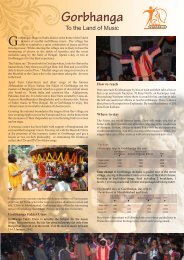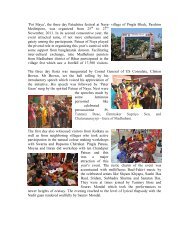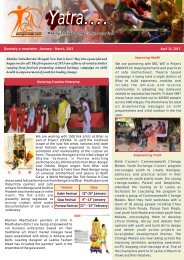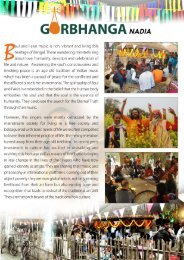Child Marriage Prevention - Banglanatak
Child Marriage Prevention - Banglanatak
Child Marriage Prevention - Banglanatak
You also want an ePaper? Increase the reach of your titles
YUMPU automatically turns print PDFs into web optimized ePapers that Google loves.
Audience ResponseQuestion answer sessions were held after the shows. All respondents could say that childmarriage is illegal and girls who become pregnant in minor age are at a greater risk as theyare not physically fit for motherhood. 93% said that it is the parents duty to educate the girlchild. 80% said that education empowers girls for earning their own living. 93% said thatthey would contact the Panchayat if they learn about child marriage. 87% felt that they willwork for building awareness among people on problems of child marriage.Sensitisation workshops with village adolescents12 workshops were held with both school going children and out of school girls. After thetheatre shows the local club members, SHG members, members of CBOs & GPs wereconsulted to mobilize them and arrange workshops with adolescent girls and boys. In somecases teachers were enthused to participate in the workshops held in their locality afterwatching the shows. 420 participants attended the workshops. The objective of theworkshop was to make the girls aware of their rights, problems of early marriage,vulnerability to trafficking and HIV/AIDS and to encourage them to take a leading role insensitizing their peers. Discussions were also held on the various laws against earlymarriage, dowry, domestic violence etc. Participatory activities were held to bring aboutattitudinal orientation to work together for prevention of child marriage. Flip charts wereused to sensitise them on problems of child marriage, sexual harassment, dowry and alsowomen health issues.3
Campaign LearningConsultation with villagers including both adults and children highlighted the followingfactors leading to high prevalence of child marriage in English Bazaar and Manikchak.• Poverty and unemployment are push factors. Displacement owing to environmentalreasons is a factor at Manikchak. Families are forced to migrate as they are losing theirland owing to rapid river bank erosion. In villages like Ballutola, Ashimtola,Barobagan, Jesharttola, Natun Dharampur and Nurpur in Gopalpur , Dharampur andEnaetpur GPs, families said that uncertainty of livelihood has led to wide prevalence ofchild marriage.• Poor status of women , lack of awareness on women’s health and lack of familyplanning are factors causing high prevalence , especially in Muslim communities.Average number of children per household is 3-5. These families try to get their girlchild married as soon as possible. ICDS workers and ANMs shared that though theytry to sensitize the girls and their mothers on the ill effect of early marriage, the maleguardians overrule them and take family decisions. There is need for awarenessprogrammes for men.• Boys start earning living from around 16-17 years. Rate of drop out is high in both theblocks. Most of the boys give up their education and work as labourers in Malda townor in other states. They are them typically married off by their families.• There is high vulnerability human trafficking. In Englishbazar -Jadupur I, Jadupur II ,Narhatta and in Manikchak block Enayetpur, Nurpur and Dharampur GP may beespecially mentioned. Marrying off young girls (Age 13-16) to grooms from distantstates like UP, Bihar and Jharkhand is common. The parents do not even report toadministration or police when the girls remain untraced.4
Way forward• There is need for a Help line so that girls and community members can get propersupport if they want to prevent early marriage.• Adolescent education empowering young boys and girls with life skills as well asknowledge of sexual and reproductive health is needed so that they are able to makebetter choices.• There is need to focus on strengthening implementation of the schemes for vocationalskill development and education of drop out girls in these villages.• Campaigns through media as well as IPC on the ill-effect the early marriage and thelaw regarding child marriage, dowry, trafficking and domestic violence is required.• There is need to develop a system for stronger law enforcement.5
The participants shared the following :• Schemes for SC, ST and OBC are unavailable from GP .The book grant facility isalso unavailable. The poor families are unable to continue their girl’s educationdespite their interest in studies.• In many villages, religious leader are involved in child marriage. Parents andguardians are either scared or religiously or socially dependent on them.• No help line available.• School children mentioned that life style education & sex education are absent intheir schools.• Poverty is always not the issue. Lure of good money from prospective groomsacross the state like Bihar and UP as well as societal pressure also are major factors.The girls identified the following needs:• Girls, who are educated try and protest against early marriage but are unable to doanything against their guardians. After attending the workshop and with theknowledge that child marriage is illegal and a punishable offence they said theywill call either the police or DSWO if any case of child marriage takes place. Theysaid they will also protest against the system of dowry.• They will mobilize the girls and parents on registering their marriage.• They will try to alert their neighbors and friends about trafficking.7
Campaign in Manikchak BlockThe following provides details on the show locations and total audience reach.Audience Feedback• Villager were unaware of trafficking, but after watching the show they could relatethe issue with early marriage. Local club members-CBO members and SHGmembers said that they would be alert and conscious when any marriage proposalcomes from different states.• Many club members and SHG members of Chawki Mirhadpur and Dharampur GPhad huge grievance about lack of Panchayat support. They felt that key persons inthe community like GP members, teachers and religious leaders support childmarriage. Sometimes marriage registrars also do not reveal actual age. One MabudAli member of club at Kalindri village shared that a villager named Bator Tantihad organized his girl’s marriage (age 13 years) with a groom from UP, and he alsogot a good sum of money from them. The club members protested and even calledthe police . Abu Taleb, the GP member requested these youths to let the ceremonycontinue as the poor family had received a fair amount of money and it would befurther difficult for the parents to get their child married again .• Illiteracy, ignorance about health & hygiene issues, poor family planning andpoverty, are some major issue leading to early marriage. The villagers becomemigrant due to huge loss of land owing to widescale river bed erosion. Theybecome landless, poor and have no other option as to seek job elsewhere. As soonas they settle in outside states, they tend to marry off their children. The villagersfelt that frequent discussions by ASHAs and ANM may help.Workshop with girlsWorkshops were held in schools and library.The adolescents shared the following• Of the total marriage that takes place in Uttarpara, Kalindri and Ramnagar villagesabout 30-40% are child marriages. The general age of the girls during marriage isbetween 13-15 years.• <strong>Marriage</strong> registration is almost nil.• <strong>Marriage</strong> takes place with grooms from states like UP, MP and Bihar. 2-3% of thegirls remains untraced.• Domestic’s violence is relatively common for dowry and early marriage.• Girls stated that more schools like SSK and MSK are needed in Paschim Sekhpura,Ramnagar and Kalindri.8
• A major problem identified by the girls was lack of communication. News paperhardly reach these places.The girls suggested the following :• More awareness programmes are needed on laws regarding domestic violence,dowry and early marriage.• A monthly or weekly meeting or session would be very effective for adolescentgirls and boys by some health worker.• Members CBOs, SHGs,GP members need to be mobilised for working to preventchild marriage.• 24 hours help line should be available.• Law enforcement agencies need to take punitive action against those involved inearly marriage-dowry and domestic violence. Such steps will act as prohibitiveagainst further such incidents9
Annexure II: Photographs10
Awareness campaign in Englishbazar blockAwareness campaign in Kazigram HighSchoolTheatre show in Phulberia GPQuiz session after the show in NarhattaMember of Gram Unnayan Samityaddressing the issue of trafficking at postshow session in BarampurGP members, CBO and SHG memberswatching show in Sudhalyapur villageFeedback taking from audience aftershow in Jodupur II GP11
Awareness campaign in Manikchak blockFolk song being used during the theatreshowVillagers watching the show inDharampurQuiz session after the show in PaschimSekhpuraToken gift given to the correctrespondent in quiz sessionFeedback taking from girls & boys inpost show session in DharampurProblem sharing with teachers & clubmembers in Enayetpur12
Sensitization workshop in EnglishbazarWorkshop at Gopinathpur on 25.04.10Alertness exercise during the workshop inSantabaidya High School on 28.04.10Workshop in Moslempur on 09.05.10Participants writing their suggestions inSudhalyapur on 02.05.10Workshop in Babupur on 27.04.10Case study reading by a girl atworkshop in Parbatta on 25.04.1013
Sensitization workshop in Manikchak BlockWorkshop with girls in Kalindri on09.05.10Workshop with students of DharampurMSK on 10.05.10Workshop at Ramnagar village on11.05.10Workshop at Paschim Sekhpura on03.05.10Girls discussing their action plan withthe flip chart during workshop inLalbathani on 30.04.1014










